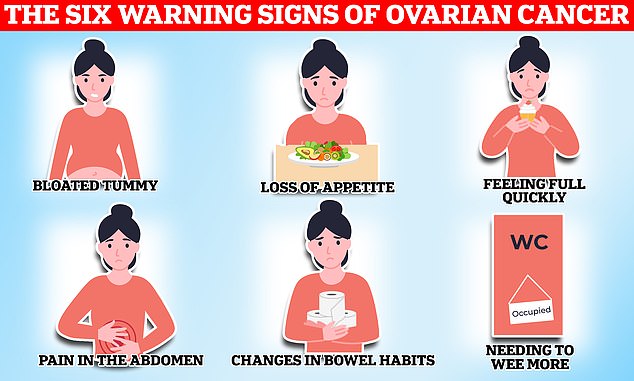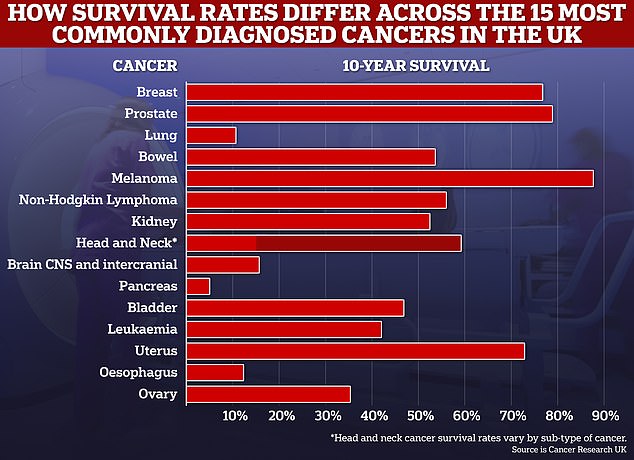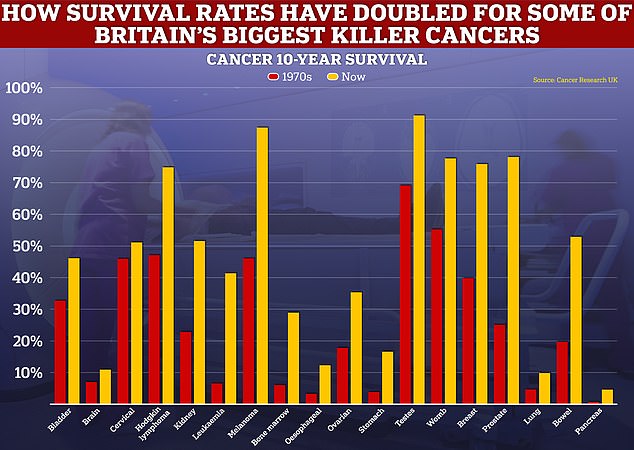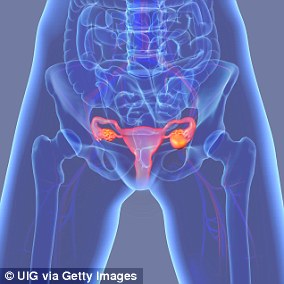‘Dr Google’ could be used in the future to spot cases of ovarian cancer up to a year earlier, researchers have suggested.
Women battling the disease watched for symptoms including weight loss, bladder problems and bloating for up to 360 days before being referred to a specialist.
Google also saw a “surge” in searches for urinary symptoms – an important warning sign of cancer – up to four months before a doctor’s referral.
Pelvic pain also apparently occurred 70 days beforehand.
Researchers from Imperial College London, who tracked the Google search histories of 235 women, claimed the data ‘offers huge potential in health and disease screening’ – although patients have long been discouraged from Googling their symptoms.

Women battling the disease watched for symptoms including weight loss, bladder problems and bloating for up to 360 days before being referred to a specialist. Google also saw a “surge” in searches for urinary symptoms – an important warning sign of cancer – up to four months before a doctor’s referral. Pelvic pain also apparently occurred 70 days beforehand


The disease kills an average of 11 women every day in the UK, or 4,000 a year. It also kills three times as many people in the United States each year, figures show. When symptoms are caused by ovarian cancer, they tend to be persistent and the National Institute for Health and Care Excellence (NICE) recommends that your doctor arrange tests if you experience these symptoms 12 or more times a month
The team also said it challenged the long-held belief that ovarian cancer is a ‘silent killer’, with most women thought to show little signs of the disease.
Lead author Dr. Jennifer Barcroft said: ‘Our findings show that it is possible to use search engine data to understand how conditions arise and that this may be useful for early disease detection.
‘Online search data offers enormous potential in health and disease screening, given the widespread use of the Internet worldwide.
“We hope that our research will generate interest in this new area of research.”
Ovarian cancer is the sixth most common cancer in the UK. The disease kills an average of around 11 women every day in the UK, or 4,000 a year.
It also kills three times as many women in the United States each year, figures show.
It is often diagnosed late because the symptoms are vague and may include indigestion, pelvic or abdominal pain, loss of appetite, constipation and the need to urinate more often.
About 93 percent of women diagnosed live five years or more if detected at the earliest stage, compared to just 13 percent diagnosed at stage four.
About a fifth of women with ovarian cancer are also diagnosed in the emergency department, often when it is too late for any treatment.
Co-researcher Dr. Srdjan Saso, gynecological cancer surgeon, called the disease ‘one of the deadliest cancers for women’.
He added: ‘The focus therefore remains on facilitating early disease detection.’
Britons involved in the study had their data obtained with consent using Google Takeout – a tool that allows people to download a copy of their data stored in Google products.
Using the tool’s health search filters, researchers tracked the differences in Google searches between women who had and did not have ovarian cancer.
Writing in the journal BMC Medicinethey said there were differences between those with and without positive diagnoses ‘noted as early as 360 days before medical referral’.
The predictions became more accurate about 60 days before a referral.
However, Professor Ingemar Cox, a computer science expert at University College London and senior study author, warned the findings also ‘raise important ethical and privacy issues that need to be addressed’.
It comes as a damning report last month revealed UK survival rates for five common cancers drastically lagged behind other high-income nations.
Only 37.1 per cent of Britons diagnosed with ovarian cancer between 2010 and 2014 are expected to still be alive five years later.
By contrast, the rate was 46.2 percent, 43.2 percent and 40.3 percent in Norway, Australia and Canada.
Your browser does not support iframes.
Your browser does not support iframes.




While the level of progress in cancer survival for some forms of the disease has been rapid, such as for breast and prostate cancer, others, such as those for lung and pancreas, have only improved at a snail’s pace
Even for patients who received treatment, they were forced to endure longer waiting times – increasing the risk of their disease spreading and reducing survival prospects.
Health leaders have consistently warned that a number of key cancer targets have not been hit in recent years.
They also estimated that 40,000 cancers went undiagnosed during the first year of the pandemic alone.
Official NHS data for December on cancer waiting times shows that only seven in 10 (74.2 per cent) of patients referred acutely for suspected cancer were diagnosed or had cancer ruled out within 28 days. The target is 75 per cent.
Only nine out of ten (91.1 percent) wait a month or less for their first cancer treatment to begin after a decision to proceed with surgery, chemotherapy or radiation therapy.
The target is 96 percent, but it has never been met.


